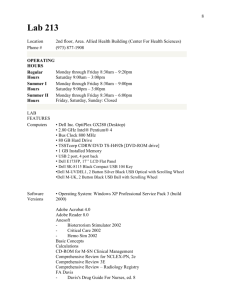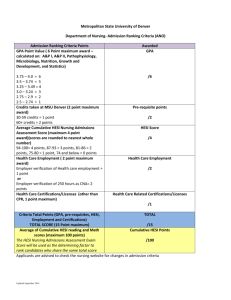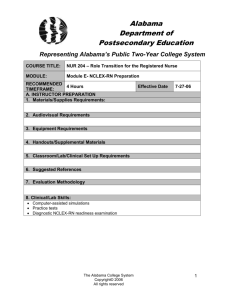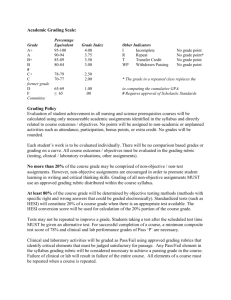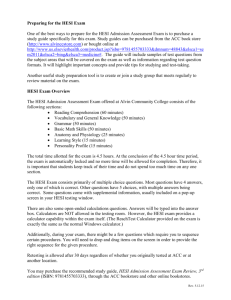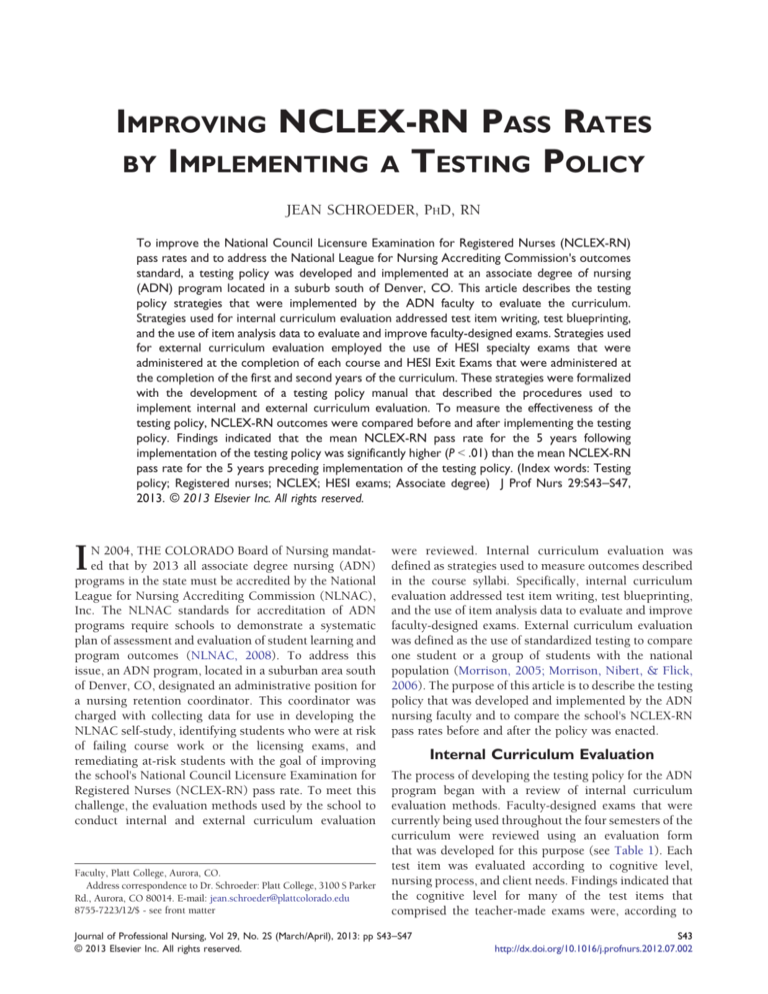
IMPROVING NCLEX-RN PASS RATES
BY IMPLEMENTING A TESTING POLICY
JEAN SCHROEDER, PHD, RN
To improve the National Council Licensure Examination for Registered Nurses (NCLEX-RN)
pass rates and to address the National League for Nursing Accrediting Commission's outcomes
standard, a testing policy was developed and implemented at an associate degree of nursing
(ADN) program located in a suburb south of Denver, CO. This article describes the testing
policy strategies that were implemented by the ADN faculty to evaluate the curriculum.
Strategies used for internal curriculum evaluation addressed test item writing, test blueprinting,
and the use of item analysis data to evaluate and improve faculty-designed exams. Strategies used
for external curriculum evaluation employed the use of HESI specialty exams that were
administered at the completion of each course and HESI Exit Exams that were administered at
the completion of the first and second years of the curriculum. These strategies were formalized
with the development of a testing policy manual that described the procedures used to
implement internal and external curriculum evaluation. To measure the effectiveness of the
testing policy, NCLEX-RN outcomes were compared before and after implementing the testing
policy. Findings indicated that the mean NCLEX-RN pass rate for the 5 years following
implementation of the testing policy was significantly higher (P b .01) than the mean NCLEX-RN
pass rate for the 5 years preceding implementation of the testing policy. (Index words: Testing
policy; Registered nurses; NCLEX; HESI exams; Associate degree) J Prof Nurs 29:S43–S47,
2013. © 2013 Elsevier Inc. All rights reserved.
I
N 2004, THE COLORADO Board of Nursing mandated that by 2013 all associate degree nursing (ADN)
programs in the state must be accredited by the National
League for Nursing Accrediting Commission (NLNAC),
Inc. The NLNAC standards for accreditation of ADN
programs require schools to demonstrate a systematic
plan of assessment and evaluation of student learning and
program outcomes (NLNAC, 2008). To address this
issue, an ADN program, located in a suburban area south
of Denver, CO, designated an administrative position for
a nursing retention coordinator. This coordinator was
charged with collecting data for use in developing the
NLNAC self-study, identifying students who were at risk
of failing course work or the licensing exams, and
remediating at-risk students with the goal of improving
the school's National Council Licensure Examination for
Registered Nurses (NCLEX-RN) pass rate. To meet this
challenge, the evaluation methods used by the school to
conduct internal and external curriculum evaluation
Faculty, Platt College, Aurora, CO.
Address correspondence to Dr. Schroeder: Platt College, 3100 S Parker
Rd., Aurora, CO 80014. E-mail: jean.schroeder@plattcolorado.edu
8755-7223/12/$ - see front matter
were reviewed. Internal curriculum evaluation was
defined as strategies used to measure outcomes described
in the course syllabi. Specifically, internal curriculum
evaluation addressed test item writing, test blueprinting,
and the use of item analysis data to evaluate and improve
faculty-designed exams. External curriculum evaluation
was defined as the use of standardized testing to compare
one student or a group of students with the national
population (Morrison, 2005; Morrison, Nibert, & Flick,
2006). The purpose of this article is to describe the testing
policy that was developed and implemented by the ADN
nursing faculty and to compare the school's NCLEX-RN
pass rates before and after the policy was enacted.
Internal Curriculum Evaluation
The process of developing the testing policy for the ADN
program began with a review of internal curriculum
evaluation methods. Faculty-designed exams that were
currently being used throughout the four semesters of the
curriculum were reviewed using an evaluation form
that was developed for this purpose (see Table 1). Each
test item was evaluated according to cognitive level,
nursing process, and client needs. Findings indicated that
the cognitive level for many of the test items that
comprised the teacher-made exams were, according to
Journal of Professional Nursing, Vol 29, No. 2S (March/April), 2013: pp S43–S47
© 2013 Elsevier Inc. All rights reserved.
S43
http://dx.doi.org/10.1016/j.profnurs.2012.07.002
S44
JEAN SCHROEDER
Table 1. Exam Evaluation Form
Exam Evaluation Form
Knowledge
Cognitive level
Comprehension
Assessment
Planning
Nursing process
Implementation
Safe and effective care
Health promotion and
maintenance
Course objectives
Objective
Objective
Objective
Objective
Application
Analysis
1
2
3
4
Client needs
Psychosocial integrity
Evaluation
Physiological integrity
The exam's test items' numbers are inserted into one of each of the three categories so that each test item number appears in this form three times.
Bloom's taxonomy (Bloom, 1956), knowledge- or comprehension-level questions. Statistical exam analysis was
limited to measuring the difficulty level of each test item,
which was the percentage of students who answered a
question correctly.
To improve the course exams, the retention coordinator conducted a faculty workshop that focused on writing
critical thinking test items, designing a test blueprint, and
conducting a scientific exam analysis. Faculty were
introduced to the four criteria for critical thinking test
items: (a) contain rationales; (b) are written at the
application or above cognitive level; (c) require multilogical thinking to answer correctly; and (d) require a
high level of discrimination to choose the correct answer
from among plausible alternatives (Morrison et al.,
2006). Table 2 provides an explanation of each of these
four criteria. The opportunity to practice writing critical
thinking test items was provided at the workshop, and
the retention coordinator consulted with the teaching
groups to assist faculty with editing current test items and
writing new questions that met these four criteria.
Faculty were encouraged to upgrade a minimum of
seven questions—editing them so that they met the four
criteria for critical thinking test items—each time an
exam was administered. The goal was to have no more
than 10% knowledge-based test items on any exam.
Additionally, exams were leveled so that by the time
students took the exams for the final course in the
curriculum, most of the questions were at the application
or analysis level. Within 2 years after the retention
coordinator role was established, most of the test items
administered within the curriculum met the four criteria
for critical thinking test items.
Faculty were also introduced to test blueprinting
(DiBartolo & Seldomridge, 2005; Morton, 2008; Tarrant,
Knierim, Hayes, & Ware, 2006) during the workshop and
had the opportunity to review a test blueprint developed
by the retention coordinator. Using the exam evaluation
form, faculty identified the objectives that were to be
tested by the exam and categorized the test items that
would be included in the exam by cognitive level, nursing
process, and client needs. Using this blueprinting process,
faculty added and subtracted test items so that the exam
contained no more than 10% knowledge-based test items.
Table 2. Criteria for Writing Critical Thinking Test Items
Criteria for writing critical
thinking test items
Explanation
1. Contain rationales
Test item rationales explain why the answer is correct and why the other choices are
incorrect. Providing rationales not only allows testing to become a learning process but
also helps reduce student dissatisfaction with test items.
2. Written at the application or above
cognitive level
Test items require students to apply content and concepts to clinical situations. Test items
are not merely the regurgitation of facts, which requires only memorizing. Rather,
students should be required to synthesize facts and concepts to solve a clinical problem.
3. Require multilogical thinking to
answer correctly
Test items require knowledge and understanding of more than one fact or concept to
solve the clinical problem presented in the question.
4. Require a high level of discrimination
to choose the correct answer
Test items require problem solving and decision making to answer correctly because the
options provided are so closely related that a high level of discrimination is required to
select the correct answer from among the plausible alternatives.
Morrison et al., 2006.
IMPLEMENTING A TESTING POLICY
To improve the exam evaluation process, a test analysis
software program was purchased. The retention coordinator served as the testing software administrator and
taught faculty how to interpret the data provided by the
test analysis program, in particular, measures of reliability. The determination of an exam's reliability, or
consistency of test scores, was reported using the
Kuder–Richardson Formula 20 (KR20) calculation. This
reliability measure ranges from − 1 to + 1, and the closer
the KR20 is to + 1, the more reliable is the exam. A KR20
of 0.60 was established as the benchmark KR20 for
teacher-made exams. To be a reliable exam, the test items
included in the exam must be discriminating; meaning,
they must be able to discriminate between those who
know the content and those who do not know the
content. The point biserial coefficient (PBCC) is a
measure of test item discrimination, and it too ranges
from − 1 to + 1. A PBCC of 0.15 was established as the
benchmark PBCC for test items included in teacher-made
exams. These data were provided by the test analysis
software program, and they were used by faculty to
evaluate test items and to revise questions (Clifton &
Schriner, 2010; Morrison, 2005). The strategies used to
implement internal curriculum evaluation were part of
the systematic plan outlined in the policy and served as
an ongoing assessment of student learning.
External Curriculum Evaluation
As a measure of external curriculum evaluation, HESI
specialty exams were administered to students throughout
the curriculum. Data obtained from these exams compared this group of ADN students with the registered
nurse (RN) student population throughout the United
States. HESI exams simulate the NCLEX-RN in that they
contain critical thinking test items, students are not
allowed to return to previously answered questions, and
the test item formats are the same as those used in the
licensure exam: four-option multiple choice, multiple
response, fill in the blank, hot spot, chart/exhibit, and drag
and drop (National Council of State Boards of Nursing
[NCSBN], 2006; Wendt & Kenney, 2009). Table 3
provides an explanation of these test item formats. These
HESI exams helped familiarize students with the type of
test items and the test administration process used by the
NCSBN, thereby helping to prepare them for the licensing
exam. Numerous researchers have reported that exposure
to the NCLEX-type questions is related to NCLEX-RN
S45
success (Bonis, Taft, & Wendler, 2007; DiBartolo &
Seldomridge, 2005; Morton, 2008).
HESI specialty exams contain 55 test items, 5 of which are
pilot items and do not contribute to the student's score.
These exams were used for external curriculum evaluation,
and students who did not achieve the faculty-designated
benchmark score of 850 were required to remediate. The
HESI Exit Exam-PN (practical nurse) was administered to
students upon completion of their first year of the
curriculum. In Colorado, ADN students who are enrolled
in community college programs are allowed to take the PN
licensure exam after completion of the first year of the
curriculum, so the HESI Exit Exam-PN helped prepare
students for the PN licensing exam. The subject matter
scores obtained from this exam were used to identify
students' academic weaknesses and to evaluate the first year
of the ADN curriculum. The HESI Exit Exam-RN was
administered in the last semester of the curriculum, and the
subject matter scores provided by this exam were used to
identify student weaknesses so that they could remediate
prior to taking the NCLEX-RN, thereby helping to ensure
their first-time success on the licensing exam. The data
provided by this exam were also used to evaluate the
nursing curriculum. The HESI Exit Exam-PN was a 110item exam, 10 of which were pilot items, and the HESI Exit
Exam-RN was a 160-item exam, 10 of which were pilot
items. Like the HESI specialty exams, 850 was the facultydesignated benchmark score for both HESI Exit Exams.
Students who did not achieve this benchmark score were
required to complete a remediation program designed by
the retention coordinator.
Testing Policy Manual
To maintain congruent implementation of internal and
external curriculum evaluation strategies, a testing policy
manual was developed by the retention coordinator in
conjunction with the curriculum committee. Morrison
et al. (2006) described the need for such a manual, and the
guidelines these authors provided served as the foundation
for developing the testing policy manual for the ADN
program. Internal curriculum evaluation topics—such as
writing style protocols used for test item writing, test
blueprinting, and benchmark statistical parameters for
exam and test item analysis—were included in the manual.
External curriculum evaluation topics—such as when each
HESI exam should be administered throughout the
curriculum, the faculty-designated benchmark scores for
these exams, and the consequences associated with failure
Table 3. NCLEX-RN Test Item Formats
Test item format
Explanation
Four-option multiple choice
Multiple response
Fill in the blank
Hot spot
Chart/Exhibit
Drag and drop
Require selection of one response from four options provided.
Require selection of more than one response from the options provided.
Require typing in the answer. Usually used for calculation questions.
Require identification of an area on a picture or graphic.
Require reading of information presented in a chart or exhibit to answer the clinical problem presented.
Require ranking of options provided to answer the question presented.
NCSBN, 2006.
S46
JEAN SCHROEDER
to achieve these benchmark scores—were also included in
the manual. The testing policy manual was provided to all
nursing faculty and became a valuable resource for
ensuring that quality evaluation methods were consistently
implemented throughout the ADN program.
Methods
To test the effectiveness of the testing policy, NCLEX-RN
pass rates were compared for the 5 years prior to
implementing the policy and the 5 years after implementing the policy. A t test was used to compare mean
NCLEX-RN pass rates before and after implementing the
testing policy. The sample consisted of 572 graduates,
304 who graduated from the ADN program before
implementation of the testing policy and 268 who
graduated from the ADN program after implementation
of the testing policy.
Findings
Findings indicated that of the 304 students who took the
NCLEX-RN before implementation of the testing policy,
271 (89.14%) passed the NCLEX-RN on their first
attempt, and of the 268 who took the NCLEX-RN after
implementation of the testing policy, 260 (97.01%)
passed the NCLEX-RN on their first attempt. A t test
determined that the two mean NCLEX-RN pass rates
were significantly different (P ≤ .01). Table 4 describes
the NCLEX-RN pass rate for the ADN program for the 5
years before and the 5 years after the testing policy was
implemented. These findings indicate that a significantly
greater proportion of students passed the NCLEX-RN on
their first attempt after the testing policy was implemented than before the testing policy was implemented.
Discussion
Focusing on evaluation improves outcomes, which is one
reason why the NLNAC requires ADN programs to
demonstrate a systematic plan for evaluation of student
learning in their self-study for accreditation. Improving
evaluation by implementing consistent, curriculum-wide
strategies to measure internal and external curriculum
evaluation helped to improve the product produced by the
ADN program—ADN graduates. A significantly greater
proportion of graduates who enrolled in the ADN
program after the testing policy was implemented passed
the NCLEX-RN on their first attempt than those who
enrolled in the program before the testing policy was
implemented. However, fewer students completed the
ADN program after the testing policy was implemented,
11.84% less. This decrease in the number of graduates
could have been because of the more stringent testing
policy, and further studies on attrition and retention
should be conducted. Additionally, at the time this study
was conducted, applicants to the program were not
required to take an admission exam. Faculty noted that
students who entered the program with academic
weaknesses, such as poor reading and/or math skills,
were more likely to withdraw from the program than
those who had the academic background to succeed in the
ADN program. Therefore, in 2011, the faculty voted to
administer the HESI Admission Assessment to all
applicants and to study the usefulness of the data provided
by this exam in determining which applicants are most
likely to succeed in the ADN program.
To help prepare students for the ADN curriculum, all
students were required to attend a 3-hour test-taking skills
workshop during the first semester of the curriculum,
which was designed and implemented by the retention
coordinator. Additionally, HESI exams were administered
throughout the ADN curriculum as a measure external
curriculum evaluation, and students who scored lower
than 850 were required to remediate. This remediation
required students to review the HESI test items they
answered incorrectly and examine the electronic links to
textbook citations that are provided in the rationales for
questions answered incorrectly. These citations are stored
electronically in the students' individual online files and
can be accessed at any time for additional review. Students
were also required to answer NCLEX-RN practice test
items contained in review books and online review
products. Knowledge of content and concepts related to
nursing practice is essential, and these electronic links to
textbook citations and the NCLEX-RN practice test items
helped to reinforce such knowledge. However, to correctly
answer questions contained on HESI exams and the
NCLEX-RN and, in fact, to effectively practice nursing,
students and graduates must also be able to apply this
knowledge and these concepts to clinical situations. The
faculty believed that remediation that focused on the
application of knowledge and concepts to clinical problems
Table 4. Comparison of NCLEX-RN Pass Rates Before and After Implementation of Testing Policy
Before implementation of testing policy
After implementation of testing policy
Year
2002
2003
2004
2005
2006
Total
2007
2008
2009
2010
2011
Total
Number
Number failed
% NCLEX-RN pass rate
45
5
89.8
43
4
90.7
76
8
89.5
70
7
90
70
9
87.1
304
33
64
5
92.2
42
2
95.2
49
0
100
56
0
100
57
1
98.8
268
8
Mean pass rate
SD pass rate
t
⁎ P b .01.
89.3
1.37
4.835 ⁎
97.2
3.38
IMPLEMENTING A TESTING POLICY
would be a better remediation resource for students
preparing for the licensure exam. Therefore, in 2011, the
faculty voted to implement the HESI online case studies as
an additional resource for student remediation. Further
study is needed to determine the effectiveness of these
remediation resources.
After developing the testing policy and establishing
benchmarks for exam analysis, the software program that
was used for exam analysis was discontinued. Consequently, the faculty members were required to calculate
test item difficulty levels and discrimination findings
without the benefit of a software program. The faculty is
currently investigating other software products that can
provide the same test analysis data, which is essential for
conducting a scientific exam analysis.
The HESI Exit Exam-RN was administered during the last
semester of the ADN curriculum, and students who scored
lower than the faculty-designated benchmark score of 850
were counseled to complete the remediation described and
encouraged to take an NCLEX-RN review course of their
choice. However, these students were not required to retest
with a parallel version of the HESI Exit Exam-RN, so the
effectiveness of their remediation could not be determined
until they took the licensing exam. Future studies might
examine the value of implementing a retesting policy for
those students who fail to achieve the faculty-designated
benchmark score on the HESI Exit Exam-RN.
Conclusions
The study school demonstrated a commitment to
improving outcomes by designating an administrative
position for a retention coordinator who, in conjunction
with the faculty, developed testing strategies that focused
on internal and external curriculum evaluation. These
strategies were formalized into a testing policy manual,
which was distributed to all faculty, and the strategies
described in this manual were implemented throughout
the curriculum. The internal and external curriculum
evaluation strategies that were part of the testing policy
fulfilled the NLNAC requirement for a systemic plan for
ongoing assessment of student learning and curriculum
evaluation. Internal curriculum evaluation strategies
focused on test item writing, test blueprinting, and
exam analysis as a means of improving curricular
S47
outcomes. External curriculum evaluation strategies
incorporated standardized HESI exams throughout the
curriculum that were used to identify students at risk of
failing the NCLEX-RN and to guide their remediation
efforts. The faculty determined that these testing policies
were effective as evidenced by achieving NLNAC
accreditation and significantly improving NCLEX-RN
pass rates.
References
Bloom, B. S. (1956). Taxonomy of educational objectives:
Handbook I: Cognitive domain. New York: Longman.
Bonis, S., Taft, L., & Wendler, M. C. (2007). Strategies to
promote success on the NCLEX-RN: An evidence-based
approach using the ACE star model of knowledge transformation. Nursing Education Perspectives, 28, 82–87.
Clifton, S. L., & Schriner, C. L. (2010). Assessing the quality
of multiple-choice test items. Nurse Educator, 35, 12–16.
DiBartolo, M. C., & Seldomridge, L. A. (2005). A review of
intervention studies to promote NCLEX-RN success of
baccalaureate students. Nurse Educator, 30, 166–171.
Morrison, S. (2005). Improving NCLEX-RN pass rates
through internal and external curriculum evaluation. In M. H.
Oermann & K. T. Heinrich (Eds.). Annual review of nursing
education: Volume 3, 2005: Strategies for teaching, assessment,
and program planning (pp. 77–94). New York: Springer
Publishing Company.
Morrison, S., Nibert, A., & Flick, J. (2006). Critical thinking
and test item writing (2nd ed.). Houston, TX: Health Education
Systems, Inc.
Morton, A. M. (2008). Improving NCLEX scores with
structured learning assistance. Nurse Educator, 31, 163–165.
National Council of State Boards of Nursing. (2006). Fast
facts about alternate item formats and the NCLEX exam.
Retrieved January 10, 2013, from https://www.ncsbn.org/pdfs/
01_08_04_Alt_Itm.pdf.
National League for Nursing Accrediting Commission, Inc.
(2008). NLNAC standards and criteria: Associate degree
programs in nursing. Retrieved January 10, 2013, from http://
www.nlnac.org/manuals/SC2008_ASSOCIATE.pdf.
Tarrant, M., Knierim, A., Hayes, S. K., & Ware, J. (2006). The
frequency of item writing flaws in multiple-choice questions
used in high stakes nursing assessments. Nurse Education
Today, 26, 662–671.
Wendt, A., & Kenney, L. E. (2009). Alternate item types:
Continuing the quest for authentic testing. Journal of Nursing
Education, 48, 150–156.


